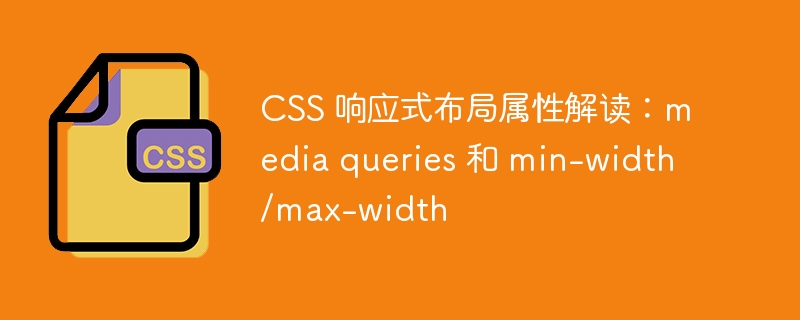 Web Front-end
Web Front-end
 CSS Tutorial
CSS Tutorial
 Interpretation of CSS responsive layout properties: media queries and min-width/max-width
Interpretation of CSS responsive layout properties: media queries and min-width/max-width
Interpretation of CSS responsive layout properties: media queries and min-width/max-width

CSS responsive layout is a layout method that can automatically adapt to the screen size and resolution of different devices. In CSS, there are two main properties used to implement responsive layout: media queries and min-width/max-width.
First, let’s interpret media queries. It is a feature in CSS3 through which we can apply corresponding styles according to different media types and browser widths. Before using media queries, you first need to understand the media types, such as screen (for computer screens), print (for printers), speech (for speech synthesizers), etc. Next we use a specific code example to illustrate how to use media queries.
/* 当浏览器宽度小于600px时,应用以下样式 */
@media screen and (max-width: 600px) {
body {
background-color: lightblue;
}
h1 {
color: red;
}
}
/* 当浏览器宽度大于600px时,应用以下样式 */
@media screen and (min-width: 601px) {
body {
background-color: lightgreen;
}
h1 {
color: blue;
}
}In the above code, we use the @media keyword to define the media query, and specify the media type as computer screen through the screen keyword. Then use the and keyword to connect the media type and a conditional expression, which consists of the max-width or min-width attribute and a specific width value. When the browser width is less than 600px, the styles defined in the first media query are applied; when the browser width is greater than 600px, the styles defined in the second media query are applied.
Next, let’s interpret the min-width and max-width attributes. They are used to limit the minimum and maximum width of an element. When the browser width is less than min-width, the element will be displayed according to the width set by min-width, and when the browser width is greater than max-width, the element will be displayed according to the width set by max-width. Here is a simple code example:
.container {
width: 100%;
max-width: 1200px;
min-width: 600px;
margin: 0 auto;
}In the above code, we create a class called .container, set its width to 100%, the maximum width to 1200px, the minimum width to 600px, and Displayed in the center through the margin attribute.
By using the min-width and max-width attributes, we can set a flexible width range for the element so that it can adapt to the screen sizes of different devices and browsers.
In summary, CSS media queries and min-width/max-width attributes are important tools for implementing responsive layout. By properly using these attributes, we can apply corresponding styles according to different media types and browser widths, thereby achieving a layout that adapts to multiple devices.
The above is the detailed content of Interpretation of CSS responsive layout properties: media queries and min-width/max-width. For more information, please follow other related articles on the PHP Chinese website!

Hot AI Tools

Undresser.AI Undress
AI-powered app for creating realistic nude photos

AI Clothes Remover
Online AI tool for removing clothes from photos.

Undress AI Tool
Undress images for free

Clothoff.io
AI clothes remover

AI Hentai Generator
Generate AI Hentai for free.

Hot Article

Hot Tools

Notepad++7.3.1
Easy-to-use and free code editor

SublimeText3 Chinese version
Chinese version, very easy to use

Zend Studio 13.0.1
Powerful PHP integrated development environment

Dreamweaver CS6
Visual web development tools

SublimeText3 Mac version
God-level code editing software (SublimeText3)

Hot Topics
 1376
1376
 52
52
 Working With GraphQL Caching
Mar 19, 2025 am 09:36 AM
Working With GraphQL Caching
Mar 19, 2025 am 09:36 AM
If you’ve recently started working with GraphQL, or reviewed its pros and cons, you’ve no doubt heard things like “GraphQL doesn’t support caching” or
 Making Your First Custom Svelte Transition
Mar 15, 2025 am 11:08 AM
Making Your First Custom Svelte Transition
Mar 15, 2025 am 11:08 AM
The Svelte transition API provides a way to animate components when they enter or leave the document, including custom Svelte transitions.
 Show, Don't Tell
Mar 16, 2025 am 11:49 AM
Show, Don't Tell
Mar 16, 2025 am 11:49 AM
How much time do you spend designing the content presentation for your websites? When you write a new blog post or create a new page, are you thinking about
 Building an Ethereum app using Redwood.js and Fauna
Mar 28, 2025 am 09:18 AM
Building an Ethereum app using Redwood.js and Fauna
Mar 28, 2025 am 09:18 AM
With the recent climb of Bitcoin’s price over 20k $USD, and to it recently breaking 30k, I thought it’s worth taking a deep dive back into creating Ethereum
 What the Heck Are npm Commands?
Mar 15, 2025 am 11:36 AM
What the Heck Are npm Commands?
Mar 15, 2025 am 11:36 AM
npm commands run various tasks for you, either as a one-off or a continuously running process for things like starting a server or compiling code.
 How do you use CSS to create text effects, such as text shadows and gradients?
Mar 14, 2025 am 11:10 AM
How do you use CSS to create text effects, such as text shadows and gradients?
Mar 14, 2025 am 11:10 AM
The article discusses using CSS for text effects like shadows and gradients, optimizing them for performance, and enhancing user experience. It also lists resources for beginners.(159 characters)
 Creating Your Own Bragdoc With Eleventy
Mar 18, 2025 am 11:23 AM
Creating Your Own Bragdoc With Eleventy
Mar 18, 2025 am 11:23 AM
No matter what stage you’re at as a developer, the tasks we complete—whether big or small—make a huge impact in our personal and professional growth.
 Let's use (X, X, X, X) for talking about specificity
Mar 24, 2025 am 10:37 AM
Let's use (X, X, X, X) for talking about specificity
Mar 24, 2025 am 10:37 AM
I was just chatting with Eric Meyer the other day and I remembered an Eric Meyer story from my formative years. I wrote a blog post about CSS specificity, and



